The Embodied Carbon Challenge
los Carbon Leadership Forum’s mission is to eliminate embodied carbon of buildings, materials, and infrastructure to create a just and thriving future.
What is embodied carbon and why does it matter?
Embodied carbon refers to the greenhouse gases (GHGs)(1) generated by the manufacturing, transportation, installation, maintenance, and disposal of construction materials used in buildings, roads, and other infrastructure.
There are two ways of categorizing the GHG emissions from the built environment:
Operational Carbon:
the emissions associated with energy used to operate a building
Embodied Carbon:
the emissions associated with materials and construction processes throughout the whole life cycle of a building
Operational carbon:
the emissions associated with energy used to operate a building
Embodied carbon:
the emissions associated with materials and construction processes throughout the whole life cycle of a building
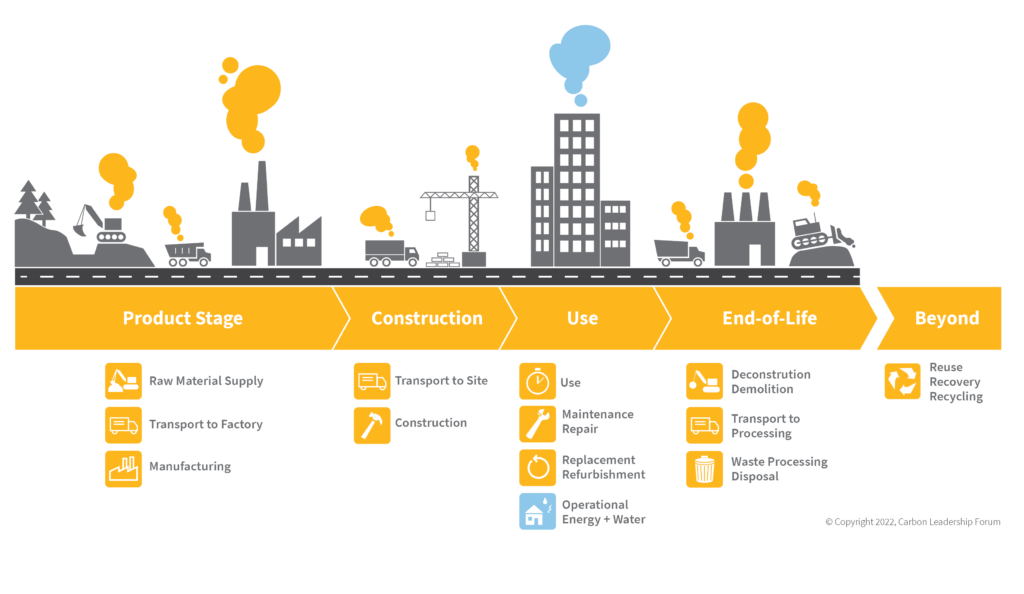

You can’t manage what you don’t measure
Evaluación del ciclo de vida (ACV) is an analysis methodology that estimates the environmental impacts of a building, product, or process over its full life cycle, from raw material extraction through end-of-life and disposal. LCA models do so by mapping all of the inputs and outputs of materials and energy through a system over time and consistently reporting resultant environmental impacts. LCA is one of the prime methodologies used by the CLF.
One impact that LCA models calculate is the total contribution to climate change. These impacts are reported as global warming potential (GWP), referred to in short as “embodied carbon.”
Learn more about how embodied carbon is measured using life cycle assessment by clicking the button below.
The importance of getting carbon assessments right
Measuring embodied carbon is key to evaluating the highest-impact, most cost-effective solutions to reducing carbon emissions.
The effectiveness of embodied carbon policies in driving emissions reductions also depends on the standards and tools required to verify compliance with policies.
Getting carbon assessments right is critical to:


Getting carbon assessments right is critical to:


We need high-quality, trustworthy, transparent, and up-to-date embodied carbon data.
Four things you should know about
carbono incorporado

1. Embodied carbon is significant
Buildings are a top contributor to global climate change
Building operations aren’t the only sector of emissions impacted by buildings. When considered over the full life cycle, the impacts of the built environment are also spread across different sectors, such as:
Due to this complexity, it can be hard to untangle and estimate the true global impact of embodied carbon and buildings as a whole. We know that at a minimum, buildings are responsible for almost 40% of global energy-related greenhouse gas emissions.(2)
Tackling embodied carbon is key to addressing industrial emissions
| The largest contributor to global emissions is the industrial sector, contributing to approximately 30% of global emissions (ver Figura 1). |
Building materials are one of the largest sources of industrial emissions and therefore are potential solutions for reducing emissions from this sector. The top two industrial sectors alone—steel and cement—are each individually responsible for more emissions than all of commercial building energy use each year (see Figure 1).
In addition to being the largest sector, industry is also frequently cited the “critical-to-abate” because (1) many key industrial processes require high-temperature heat that can’t yet be reliably replaced by clean energy(3, 2) industrial and fuel transformation processes release CO2 and other pollutants directly into the air. For these reasons, industrial emissions can’t simply be reduced through a transition to clean power and electrification, which is more technically feasible with transportation and building operations.
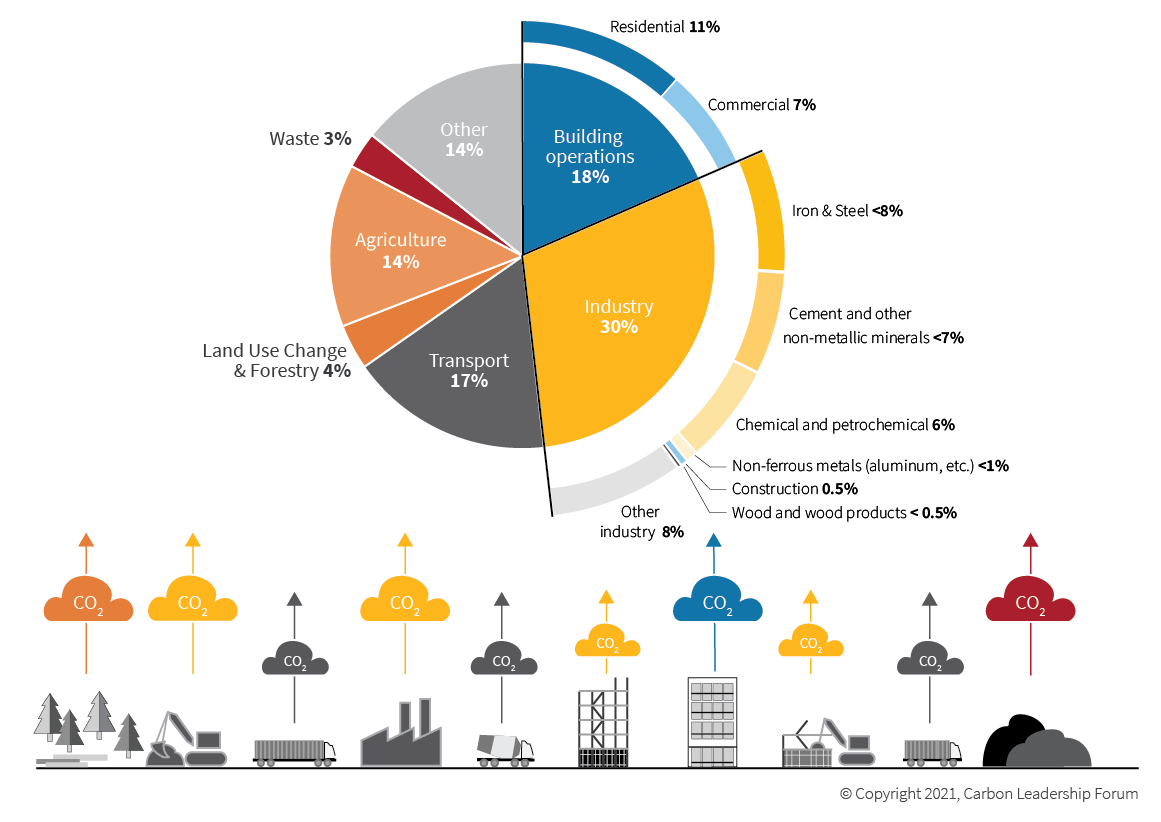
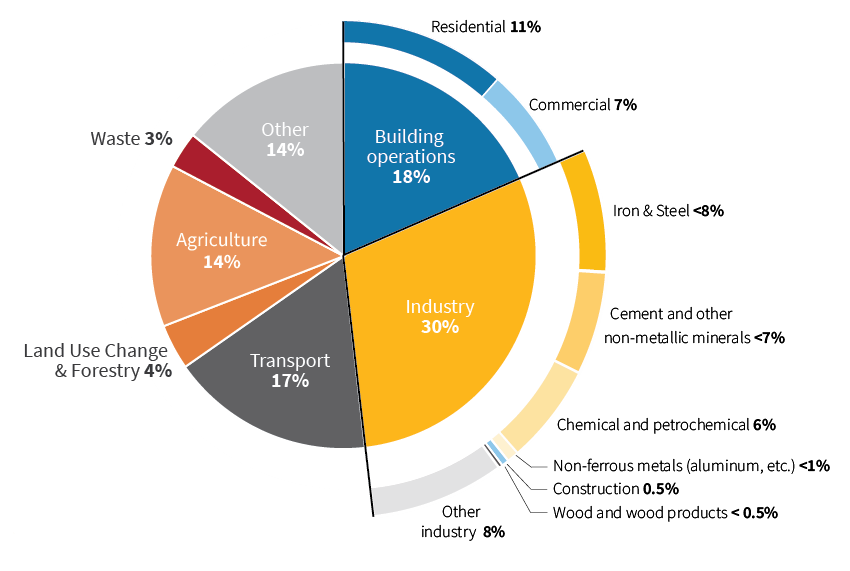
Figure 1. Global greenhouse gas emissions and the life cycle of buildings. When considered over the full life cycle of building products, the building industry influences nearly every major sector of global GHG emissions. Emissions data from IEA and WRI Climate Watch (2016 GHG emissions data).
2. Embodied carbon is an urgent problem
In order to avoid the most catastrophic impacts of climate change, it is essential that we reduce embodied carbon now, and develop a pathway to low-carbon construction on every building project. Transforming the building industry cannot wait.
Emissions released now are more critical than emissions released later because:
 |
Greenhouse gas emissions accumulate in the atmosphere, and persist for long periods of time |
 |
There is limited time remaining before the tipping point of the climate crisis (this idea is known as “carbon lock-in”)4 |
Once upfront embodied carbon emissions are released into the atmosphere, we can’t take them back and they start affecting the climate immediately. In contrast, operational carbon generated from the daily operations of a building can be decreased over time thanks to ongoing energy efficiency efforts and grid decarbonization.
Up to two-thirds of the total carbon for a high-performance building constructed in 2020 could be attributed to embodied carbon emitted in the first ten years of a building’s life (by 2030). By 2050, approximately half of a building’s lifetime emissions could be attributed to embodied carbon (see Figure 2).
It is important to note that many of the most impactful decisions related to embodied carbon happen in the early stages of a design project. Due to the project schedules for large projects, this means that early design choices being made today are locking in emissions for a building that may not open for another 5-10 years.
If we wait to tackle embodied carbon until after we have “fixed” operational carbon, we will be too late. Architects, engineers, contractors, suppliers, and policymakers need to step up now to take action on embodied carbon.
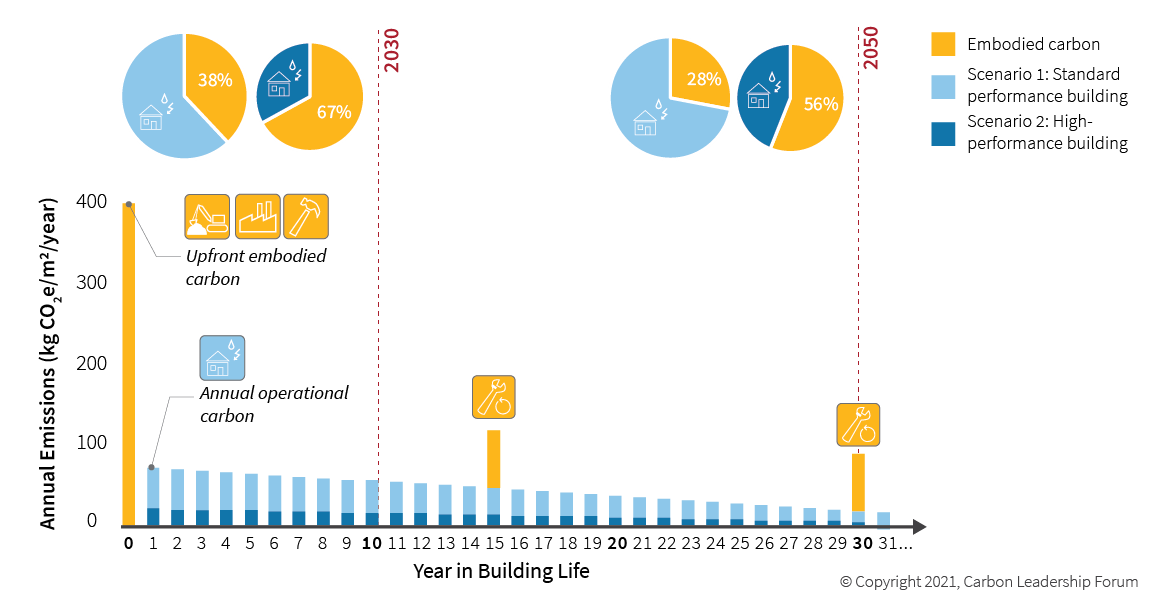

Figure 2. Relative impact of embodied and operational carbon of a new building from 2020-2050. Emissions data from the CLF Embodied Carbon Benchmark Study and Commercial Buildings Energy Consumption Survey (CBECS), assuming a medium-sized commercial office building. Assumes gradual grid decarbonization to zero by 2050.
3. Embodied carbon is directly linked to public health and equity
Embodied carbon and climate justice
The concept of a Just Transition grew out of collaboration between environmental justice groups and labor unions. Just Transition aims to move away from an extractive economy to a sustainable and regenerative economy.(5) The principles of a Just Transition and the work of the climate justice movement reinforce the idea that addressing climate change and equity cannot be done in isolation. The transition to a low-carbon future itself must be equitable and create space to focus on new structures of power and accountability.
Embodied carbon is inherently connected to climate justice and issues of public health and equity. Its impact can be seen locally in communities adjacent to construction supply chains and globally in frontline communities.
On a local scale, low-income communities and communities of color are more likely to be located near sources of pollution(6,7), such as coal plants, mines, manufacturing facilities, heavy transport infrastructure, and waste disposal sites. All of these sites are parts of building supply chains and may release heavy metals, toxic chemicals, and particulate matter into the water, air, and food sources of nearby communities. These pollutants cause both short-term and long-term health problems.
4. Embodied carbon can be reduced now with available tools and strategies
Embodied carbon has long been the blind spot of the sustainable design movement and the building industry at large.
Not long ago, it was nearly impossible to find or understand the carbon footprint of some of the most common building materials. But in the past decade, there has been a surge of interest and knowledge-building to address embodied carbon. Today, we have the tools, data, and strategies necessary for designers and builders to make meaningful carbon reductions on their projects immediately.
Some of these strategies include:




Policy is an essential step towards creating the scale of action required to rapidly reduce embodied carbon in construction. Embodied carbon policies can include procurement policies (like Buy Clean and material-specific variations), Climate Action Plans, building codes, city zoning, land use, and building regulations and incentives, including building and material reuse policies, and executive orders.
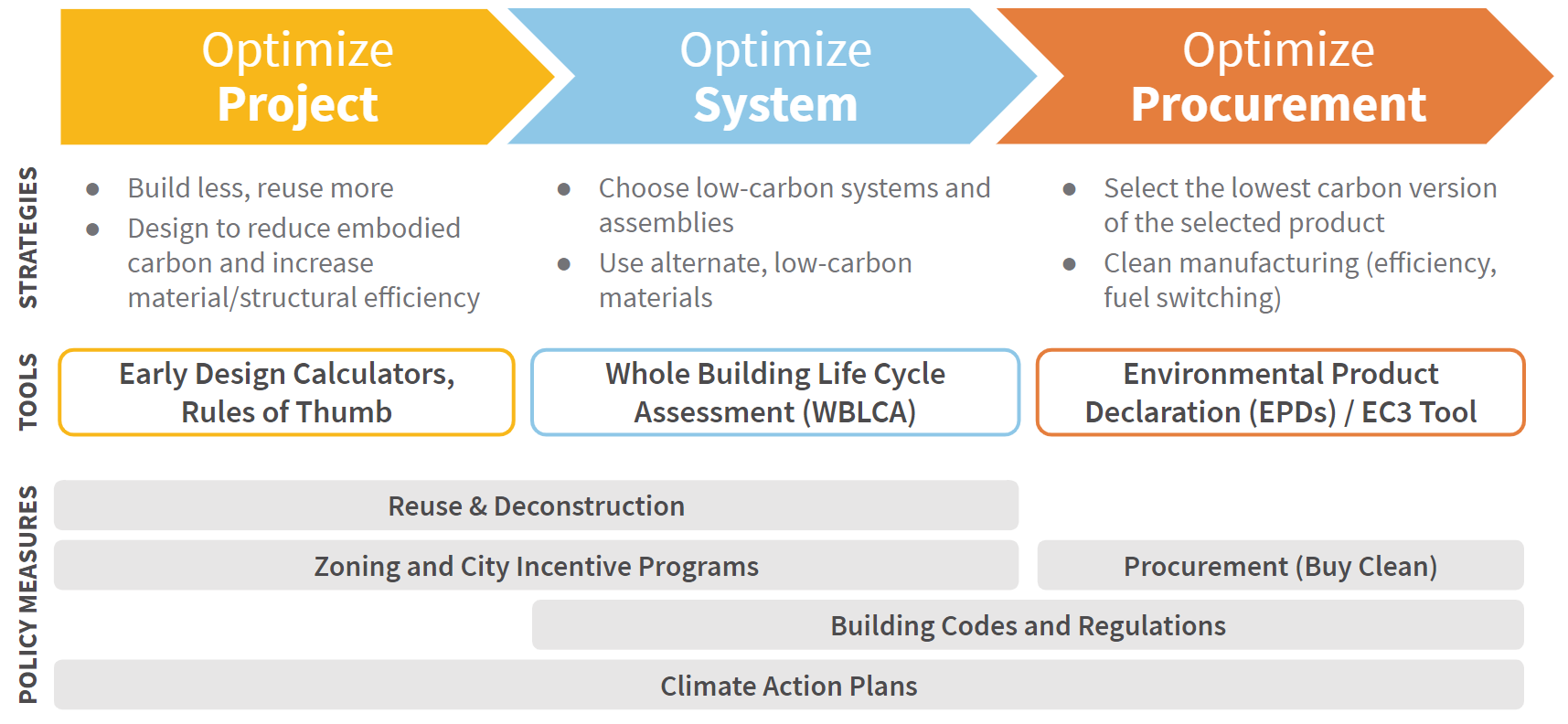
Citations
1. Greenhouse gases are substances in the atmosphere that contribute to global warming. Carbon dioxide (CO2) is the predominant greenhouse gas, making up roughly 76% of global emissions (US EPA). “Carbon” is a shorthand for greenhouse gases, and we typically report these emissions and the resulting global warming impacts in terms of carbon dioxide equivalents (CO2e).
2. UNEP and IEA. (2021). “2021 Global Status Report for Buildings and Construction.”
3. International Energy Agency. (2020). Perspectivas de tecnología energética 2020.
4. Sato, I., Elliot, B., Schumer, C. (2021, May 25). What Is Carbon Lock-in and How Can We Avoid It? World Resources Institute.
5. Climate Justice Alliance. (n.d.). Principles of Just Transition. Retrieved August 2020.
6. Center for Effective Government. (January 2016). Living in the Shadow of Danger: Poverty, Race, and Unequal Chemical Facility Hazards.
7. Co-location of low-income and communities of color can be visualized locally through federal and state environmental justice screening and mapping tools.







